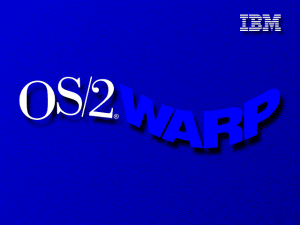OS/2 turns 25

Who, like me, once used OS/2? What, you don't know OS/2? On April 2, 1987, IBM and Microsoft announced a then revolutionary, 32-bit server and desktop operating system that was going to change the world: OS/2. Well that's what they said anyway. In reality, Bill Gates quickly decided that he'd do better by going it on his own with some operating system called Windows. You may have heard of it.
Before Linux showed up in 1991, OS/2 was Windows' main rival. It was a fun and remarkably stable and secure operating system that was a real challenger to Windows.
In its early days, OS/2 was great. Back in 1993, for example, when I was a contributing editor at Computer Shopper, we decided that OS/2 2.1 was the best operating system around over such competition as UnixWare, Windows NT, Solaris, and NeXTStep. So what happened?
On Google Plus, Esther Schindler, aka the OS/2 Goddess,, thinks "of OS/2 less as an operating system than as 'A Technology in Three Acts.'"
"Act 1 was OS/2 1.0. It was a marriage of convenience between Microsoft and IBM, in which each party imagined they were getting something different than they got. For instance, IBM told Microsoft, "We know the corporate market. You know consumers. We'll sell the OS to our corporate clients, such as financial firms, and leave the consumer market and non-enterprise businesses to you." Which is exactly what IBM did - and why OS/2 did make serious inroads at banks and other big companies, particularly for custom applications. (Which left almost no room for desktop app sales.) Meanwhile Microsoft went into their business customers and said, "I'm here to sell you OS/2 1.0... But you should know that our next version of Windows is going to be really cool."
That went over well in IBM circles.
It also didn't help any that the first version of OS/2 to show up really wasn't ready for prime time. The first version was just another character-based interface operating system. Version 1.1, with a GUI, didn't show up until October 1988. OS/2 was also, in its day, a resource hog. It needed at least 4MBs of RAM in the days when most PCs didn't have a single MB.
Act 2, OS/2 2.0 to OS/2 Warp, according to Schindler, was the "Messy divorce." Microsoft released Windows 3.0 in 1990 and paid only lip-service to OS/2. Windows 3.0 didn't work very well, but it was pretty.
Schindler remembers, "David Barnes, who for a while was IBM's OS/2 spokesman (and is the best demo-er I have ever seen, second only to Steve Jobs), once explained the difference between IBM and Microsoft. IBM was a plumbing company, David said. They knew how to design pipes that didn't leak, and how to install complex plumbing so that it never needed attention. But good plumbing is invisible. When IBM made bathroom faucets, they were designed for functionality and durability; they were not pretty. On the other hand, Microsoft was really good at making things pretty and they could design user interfaces. Someone could come into a Microsoft-designed bathroom and say, "Wow, what pretty faucets!" and be encouraged to buy the entire Microsoft package. But Microsoft didn't know plumbing (OSs) so their faucets always leaked."
Some things haven't changed. Well, except, I think Microsoft started to lose the ability to make pretty sometime around Vista and lost it entirely with Metro.
Of course, at the same time, Microsoft had enough industry clout that they'd started forcing vendors into installing only Windows on their PCs. Eventually, the Department of Justice would put an end to Microsoft's monopoly, but by that time, OS/2 was history.
Mind you, IBM, as Schindler points out, wasn't doing OS/2 any favors. OS/2, through programs like Team OS/2, developed a strong, vocal community. Any Linux fan would recognize the OS/2 fans of twenty years ago as their brothers and sisters with their passionate support online and in conferences of their operating system. Alas the IBM of twenty years ago didn't have a clue of what to do with fans or even independent software vendors (ISV)s. This was the IBM of suits and ties, not the IBM of 2000 that would embrace Linux in all its fuzzy, tie-dyed goodness.
This change of heart came too late for OS/2 though. In the third act, Schindler writes, "OS/2 Warp 4 [which appeared in September 1996] came along; the company was no longer behind it. They had publicly said they were going to do such-and-so, but at the top levels their hearts weren't in it. And one by one they dismantled what they had spent at least a decade building. … Team OS/2 fell apart, too, because how could we believe in their product if they didn't? It was a personal insult as well, because we were more committed than they were."
Despite that though, OS/2 still lives on. While IBM no longer has anything directly to do with it, EcomStation is a fully compatible OS/2 clone operating system. OS/2 is also still used in the New York subway system and in some bank ATM systems. And, yes there are still OS/2 fans out there. Operating system may grow old, they may be abandoned, but they almost never truly die.
Related Stories:
UNIVAC: A look back into the birth of the computer industry
20 Years of Linux down, and the best is yet to come
